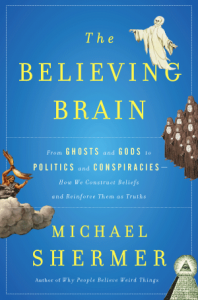Book Review: The Believing Brain by Michael Shermer

In The Believing Brain skeptic leader Michael Shermer gives a highly readable, well researched explanation as to why people are drawn to believe things that aren’t (and are) true. He draws on both neuroscience and social sciences to show that people are pre-disposed to see patterns in natural events, and further to ascribe reasons to those patterns. It is this this pre-disposition that helps explain why people believe in all sorts of things, from God to conspiracy theories to political convictions.
Shermer identifies two major factors in the pre-disposition for belief. The first is what he calls Patternicity—the tendency and ability of people to seek and find meaningful patterns in both meaningful and (key to his arguments in the book) meaningless events. This ability to detect patterns was an important step in human evolution and gave us significant advantages. By detecting patterns, we could deduce what was likely to come next.
At its most basic, picture the hominid walking along the savanna three million years ago. He hears a rustle in the grass. By recognizing a pattern he knows it could be a predator. If he is quick to assume it is a predator, he jumps off the trail and hides. Without pattern recognition he would continue to walk down the path. If it is a predator, the one who recognized the pattern is safe; the one who did not is dead. But significantly, there is no similar reverse punishment for an incorrect pattern recognition. If it was just the wind, the one which reacted to the perceived pattern loses only a few moments time in hiding, and then goes on. Acting on patterns where none exist often has no immediate downside. Too little pattern recognition is punished. Too much pattern recognition is not.
The second major factor he identifies is Agenticity–the inborn drive to infuse the patterns we do find with meaning and intentional agents to explain why things happen as they do. People do not like to believe, quite simply, that anything happens at random. They look for the causes and who or what is behind the causes. While Shermer points out rightly that this is actually the first step to understanding, he shows how, taken too far, it encourages people to think that there is an intention to anything that happens. Storms are not just a collection on natural events but become a punishment sent to enforce social norms. The social order is reinforced through this suggestion of agency, even if there actually is no agency behind it, thereby even presenting a bit of benefit to the error of ascribing agency.
Shermer then applies this analysis to five successive areas of belief; the afterlife, God, aliens, conspiracies, and politics. In each chapter he sets out what is believed, what we know, and how—despite what we know—certain beliefs persist.
But most significantly, he identifies that the beliefs we first come to from identifying patterns are so strong that after we adopt the belief they are almost impossible to shake. As he states, “Beliefs come first, the explanation for the beliefs follow.” Once the belief is formed, the brain looks for confirmation of the belief, quickly noting evidence that supports the belief, while even more quickly discounting, and even forgetting, evidence that goes against the belief. Anecdotal evidence is gathered, then cited as proof for the belief, even in the face of more scientific evidence. The continuing supposed debate between evolution and creationism is a prime example of this type of denial.
The solution to these patterns, biases and beliefs, he argues in the last chapters of the book, is nothing other than the scientific method, rigorously applied. On some issues this makes the answers obvious, such as UFOs, ESP and alien visitation. His chapter on belief in God, its historical utility in enforcing social stability, and its increasing limits as a framework for society, is especially enlightening. On political questions, it provides a framework where it at least discussion can begin with a better understanding of why others may believe strongly but differently from yourself.
The Believing Brain is both entertaining and informative throughout. Shermer’s explanations and arguments are buttressed with evidence and explanations of the science involved. They are well illustrated with humor and personal experiences. Occasionally in the middle portion of the book the scientific explanations veer a little on the side of overkill, especially for the more general reader, but not too far and not for long, and it’s comforting to know that the science is there. But push on, and you will be rewarded with a thought-provoking read that will have you revisiting and reviewing your own beliefs, as rational as they may have seemed to you, with a fresh perspective.
The Believing Brain is available on Amazon.com.
